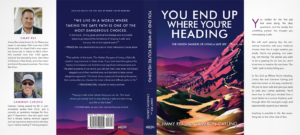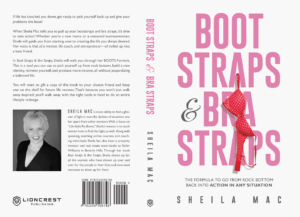Using Reviews on Back Cover Self Published Book
The front end cover is a reader's first impression of your book.
"Is this a book I might want to read?"
If a reader is hooked by your volume title, intrigued by the subtitle, and impressed by the front end embrace pattern, then the back cover of your non-fiction volume has 3 jobs at in one case:
- The description tells the reader what they'll go out of reading the book.
- The short bio tells them why you're the right person to write that volume.
- The overall blueprint of the embrace (and the quality of the copywriting) tells them if the book is professional person and valuable.
Basically, the cover gets them interested; so the back cover helps the reader decide whether or not they want to go any further.
Because it has 3 jobs—visual, informative, and persuasive—the back of your volume is really a combination of marketing copy and design.
This post will walk you lot through both aspects of the back embrace, as well equally how to cull the right designer for your book and how to write back embrace copy that will take hold of a buyer'south attention.
How to Design Your Dorsum Cover
I of the first things to empathise well-nigh book comprehend design is that the back cover of a book is an integral office of the whole. You tin can't pattern the back without designing the entire thing.
When books are printed, the cover is created every bit one whole epitome on a special sail of thick paper called cover stock. The image includes the front end, spine, and back. Then that cover is cut to the correct size and folded to course the volume'southward binding.
And so you never want to pattern the back of the book by itself. The whole cover of your volume needs to be sent to the printer as a unmarried pdf file, and information technology should be created that manner.
Your book'due south printer volition also have specific requirements for the back book cover or volume jacket, like where the ISBN barcode goes, and the correct color contour and settings for your pdf file.
And, if yous're including an Author photograph, it needs to look just every bit professional equally your volume and work well with the rest of the design.
Only even across the technical aspects of a practiced volume cover, there's an art to laying out the text of the back comprehend re-create. It isn't anything like just typing up a letter and printing information technology.
Designing a dorsum embrace that will hold a reader's attention is a combination of artistic design principles and a print specialty known equally typography.
Typography: words as design
Typography is the art of arranging type to be piece of cake and appealing to read, especially when it's printed. Modern volume designers have to know how to do that for both digital and impress formats.
Since book covers today are created on computers, digital book covers take the reward of looking the aforementioned style on Amazon equally they do on the designer'southward screen.
But print is a whole different story.
Digital images are made of low-cal—light literally forms the picture show, which is why your computer screen is dark when it isn't on. There's no light to make any images.
Print images are made by ink that's printed onto a physical page. That's why printed images aren't every bit brilliant as digital ones—they're but reflecting light, not made of information technology.
So the type on your back cover has to be easy to read either way, and the colors have to look expert in both media. If you hold a printed book up to an image of the same book on Amazon, you'll come across that the colors aren't exactly the same.
Printing gets even more complicated because printed ink bleeds, if only a little. And so, blazon that looks great on a estimator screen tin be likewise thick or too thin in impress, depending on what other colors are next to it.
Here's the deal: the typography of volume design isn't just art. It's also technological know-how and a lot of math.
Typographers choose a professional font and manipulate information technology by making it thicker or thinner, spacing the messages closer together or farther autonomously, and fifty-fifty manus-tooling the individual letters to brand your dorsum cover copy expect make clean and professional.
If you don't know how to practise those things, or fifty-fifty if you lot have experience doing it digitally but not in print, that lack of experience is going to be obvious to the reader.
They won't know what's wrong with it exactly, but their overall impression will exist: "Hey, there'south something inexpensive looking nigh this."
If yous desire your book to expect professional person, you should hire a professional.
Other back embrace design elements
Hopefully, I've already convinced y'all to rent a professional to design your book. But when you practice, you'll need to know a couple more things virtually dorsum embrace design to make the right option for your book.
A great book blueprint volition brand your volume experience like i coherent, professionally designed package. The look and experience of the front end will continue across the spine and onto the dorsum, oftentimes by subtly echoing the volume's cadre colors and design elements across the 3 faces of the volume.
So you lot actually need a encompass designer who isn't simply a typographical specialist within the self-publishing context, only also one with a corking eye for overall layout and composition.
It's all-time to look for one person who tin can design the front, spine, and back cover together—and I'd personally exist wary of a cover designer who doesn't provide the complete pdf you demand.
The but exception would be if you lot want custom artwork for the embrace. In that instance, you're really hiring 2 different artists:
- The illustrator, who creates the original fine art for the cover
- The typographer/designer, who lays out the encompass as a whole, placing the art into the overall design along with the title, subtitle, author proper name, and any other pattern elements
Ideally, your cover designer should specialize in your volume's genre.
If you're publishing a business concern book, look for a portfolio of bold, modern titles with color that really pops, and imagery that's minimal but full of energy.
If you're publishing a memoir, await for a portfolio with elegant, meaningful type, as well as good use of photo manipulation to set an emotional tone.
And, virtually of all, follow your gut! Always. Considering your prospective readers will besides.
Last but not to the lowest degree, your embrace designer will need you to provide them with the back cover copy.
How to Write Back Cover Copy That Sells
The dorsum cover copy of your volume consists of 2 parts (sometimes 3):
- Your book's clarification (about 150 words)
- Information about you, the Author (about 100 words)
- Ane or two dandy testimonials (sometimes called a book blurb or cover blurb), if yous have whatever (optional)
Writing your back cover clarification
The first thing to remember about your book description is that information technology's a pattern element of your volume, and so information technology has to fit naturally and easily on the back embrace.
If it's besides short, it won't give readers enough information to brand them open the book and start reading.
If it's as well long, it won't fit well on your book. No designer, no matter how professional, can make a 500-give-and-take description look good on the dorsum of a standard merchandise paperback.
So, what's the best length to shoot for?
A 150-word description strikes a great balance.
It gives yous enough room to sell the reader on the volume while giving your encompass designer enough infinite to lay it out comfortably.
Just hither'due south the most of import thing to recollect in writing your nonfiction book clarification:
It should non explain your book. Instead, it should create interest and connectedness with the reader.
Call up near your target audience, and ask what those people demand to know about your book to help them empathize how much they'll go out of reading information technology.
Writing a great book description isn't well-nigh making everyone want your book—that's impossible, and trying to do that is counterproductive. Y'all'll end up with mediocre encompass re-create that doesn't appeal strongly to anyone.
Instead, endeavour to make your specific target audition want your volume. Believe it or non, by targeting your back encompass re-create at a narrow audience, you'll stop up making your book audio a lot more interesting to a lot more people.
For more help doing that, read my full post on writing a keen book description.
Writing your back cover Author bio
The back cover Author bio commonly comes after your description and should be effectually 100 words (fewer is fine, merely I wouldn't become beneath 60 or 70).
If the clarification is about selling the volume, the bio is almost showing the reader why you're the correct person to write that book.
A lot of Authors accept trouble writing the bio, so read my full mail service on Author bios if yous'd similar more guidance on how to exercise that.
The most important thing to remember virtually all your back cover copy is that readers need to know why they should read the book.
If you've solved a problem they're currently facing—or if you lot have special data that nearly people don't have, making you lot the perfect person to write this item book—yous should share that with your readers.
Examples of Bang-up Book Dorsum Covers
ane. You Terminate Up Where You're Heading: The Subconscious Dangers of Living a Safe Life, by Jimmy Male monarch and Cameron Carling

The paradigm of a natural landscape in unnaturally vibrant colors is the perfect companion to the volume's clarification, inviting readers to stride out of their condolement zone in pictures as well every bit words.
"You settled for the first task that came along, the okay apartment, and the steady but unfulfilling partner. You thought you lot were playing information technology prophylactic."
These authors do a great job of highly-seasoned to the people who need this book by describing, in just a few words, what that reader'due south life looks like.
A lot of offset-time Authors go hung upward on the idea that they'll "turn off" potential readers by targeting their readership too narrowly. Merely that's just not how people work.
If you don't like your task but y'all accept an astonishing spouse, you won't think, "This volume doesn't describe me." Instead, you'll focus on the problem y'all practice have: "Maybe this book can help me find a task I'll like more."
Don't worry about targeting your readers too narrowly. People will resonate with the parts that fit them. If they're interested in the book for any part of their life, they'll bank check it out.
two. Boot Straps & Bra Straps: The Formula to Become from Rock Lesser Back into Action in Whatsoever Situation, by Sheila Mac

This encompass is an attention grabber. There's no doubt about it.
Notice that the title is catchy merely doesn't tell you anything about the book on its own. It's the subtitle that makes yous desire to continue reading.
If you'd like some guidelines virtually how to create this kind of rockstar title/subtitle pair, read my posts on crafting nifty titles and subtitles.
Everything almost the cover design, from the typography to the colors and layout, says "positive, feminine fun."
The description re-create sets the exact same tone, with a kickoff-line that speaks directly to the readers this book was written for:
"If life has knocked yous downward, become ready to pick yourself support and requite your issues the boot!"
3. Income Bliss: Create a Retirement Income That You lot Can't Outlive, by Bob Gardner, CLU, ChFC, RFC

Between the title, subtitle, and comprehend fine art, this encompass design sets up the clarification perfectly.
The thought of creating a retirement income that you lot tin can't outlast addresses a pain indicate for a lot of people, and the description backs up this theme with more item: it doesn't have to exist frightening; anyone can do it.
Only the closer is the Author bio, which in this case is nested in the center of the book description.
"Financial advisor and wealth management expert Bob Gardner has spent his career helping his clients build successful portfolios that accept the stability to last through their retirement, and that give them the liquidity to enjoy it."
It'south easy to promise that you can help people make money, just this Author has the credentials and experience to back information technology upwardly.
mahometthesustrach.blogspot.com
Source: https://scribemedia.com/book-back-cover/
0 Response to "Using Reviews on Back Cover Self Published Book"
Post a Comment